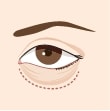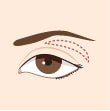- Eyelid Surgery Benefits
- Eyelid Surgery Candidates
- Eyelid Surgery Types
- Eyelid Surgery Procedure
- Eyelid Surgery Recovery
- Eyelid Surgery Results
- Eyelid Surgery Complications
- Eyelid Surgery Complementary Procedures
- Non-Surgical Blepharoplasty
- Eyelid Surgery Cost
- Eyelid Surgery Insurance Coverage
- Additional Eyelid Surgery FAQ
What Is Blepharoplasty?
Eyelid surgery, also called blepharoplasty, is a procedure performed to rejuvenate aging changes of the upper and lower eyelids. Sun exposure, gravity, and even hereditary factors contribute to excess wrinkling and sagging skin of the upper and lower eyelids. Puffy bags under the eyes are common findings, as are droopy upper eyelids, a condition called eyelid ptosis. These changes often convey a tired appearance and can even interfere with full vision.
To reverse these changes, board-certified plastic surgeons like Dr. Brian Braithwaite and Dr. Lorri Cobbins can remove excess skin, and fat to restore eyelid shape and contour. Overcorrection can be as undesirable as no correction; therefore, our doctors address these changes in a very precise manner.
Like facelift surgery, blepharoplasty can be combined safely with other surgical procedures. When performed correctly, eyelid surgery can often produce dramatic results, providing patients with many years of more youthful eyes and a well-rested appearance.
What Are the Benefits of Blepharoplasty?
The eyelid procedure can be personalized to:
- Remove extra skin responsible for upper eyelid sagging
- Diminish fat buildups and/or puffiness around the eyes
- Reduce the appearance of eyelid wrinkles and creases
- Smooth under-eye bags
In addition, blepharoplasty can create a more alert, youthful look, improve symmetry, and in some cases, enhance peripheral vision impaired by drooping skin. By tailoring the surgery to your unique anatomy and goals, results can appear natural and harmonious with your facial features, helping you look refreshed while maintaining your individual expression.
Who Is a Good Candidate for Eyelid Surgery?
To determine if you are a good candidate for eyelid surgery, your doctor will review your health history and perform an examination during your consultation. Chronic conditions such as high blood pressure, dry eye syndrome, glaucoma, and thyroid abnormalities require thorough discussion. Your doctor will carefully examine your upper face, assessing brow position, skin laxity, fat deposits, and eyelid tone and position. To help understand your goals, we recommend that you bring photographs of your younger self to the consultation. We will also take preoperative photos during your visit. At the time of the consultation, your doctor will acquire an understanding of your goals and desires, as well as review available techniques and incision sites that can most effectively help you achieve your goals with beautiful, natural-looking results.
What Types of Eyelid Surgery Are Available?
You may have concerns related to your upper eyelids, your lower eyelids, or both. During your initial consultation, our plastic surgeons will review your concerns and develop a customized program to suit your needs. Patients have the option of:

Upper Eyelid Surgery
Upper eyelid blepharoplasty addresses the issues that can develop on the upper eyelids, including excess, droopy skin that can make you look tired, upset, or older than your age. If this effect becomes severe, the loose skin may even obstruct your vision.

Lower Blepharoplasty
Lower eyelid surgery corrects under-eye bags and wrinkles under the eyes. This procedure may be accompanied by dermal filler treatment to rejuvenate the appearance of the tear trough area in the event you have bags and dark circles or volume loss.

Double-Eyelid Surgery
Double-eyelid surgery, also known as Asian eyelid surgery, is a procedure designed to create a crease in the upper eyelid. Some individuals, many of them Asian, do not have a visible fold along the upper eyelid and prefer the aesthetics of this feature.
What Happens During the Eyelid Surgery Procedure?
“I just wanted to thank you again. I will always remember your unique style of practice – don’t change…I will definitely recommend you to anyone in need of your type of skills.”
What Should I Expect During Recovery from Eyelid Surgery?
Following eyelid surgery, we usually recommend eye drops or ointments to prevent dryness. Some temporary swelling and/or bruising may occur, but these symptoms should subside relatively quickly. Rarely described as anything more than mild, any potential discomfort can typically be alleviated with medication. Patients can usually wear contact lenses and makeup within two weeks when bruising and swelling resolve, and most individuals may drive and return to work once they discontinue narcotic pain medicine. Strenuous physical activity and/or intense exercise should be avoided for at least several weeks to ensure optimal healing.
How Long Do The Results From Eyelid Surgery Last?
The average lifespan of upper eyelid surgery ranges between five and seven years, though some patients see their results last much longer. Lower eyelid surgery, on the other hand, can often last for decades, preventing you from needing a secondary lift in the future. The full range of benefits and what you can expect from your procedure will be discussed with you when your comprehensive treatment plan is developed based on your unique needs.
What Complications Are Associated with Eyelid Surgery?
As with any surgical procedure, there is the risk of certain complications with blepharoplasty. However, when eyelid surgery is performed by a board-certified plastic surgeon, the chances of having something go wrong are significantly reduced. While most side effects are mild and temporary, some of the complications associated with eyelid surgery include:
- Irritated, dry, or itchy eyes
- Issues with opening and closing your eyes
- Scarring that is more noticeable than expected
- Discolored skin tone around the eyes
- Infection and bleeding
- Temporary blurred vision
- Temporary vision loss
These risks can be mitigated by a professional, accredited surgeon who is experienced with performing eyelid surgeries. At our Chicago practice, Dr. Braithwaite and Dr. Cobbins have gone through extensive plastic surgery training, accreditation, and education. They will take every precaution to maximize the safety of your eyelid surgery and will go over the possible risks with you prior to your surgery.
Which Treatments Are Most Often Combined with Eyelid Surgery?
At The Aesthetic Institute of Chicago, many of our blepharoplasty patients choose to combine their procedure with facelift surgery, brow lift (forehead lift) surgery, and injectable fillers. Since blepharoplasty focuses on improving the appearance of the eye region, adjunctive treatments such as these can often help create a more comprehensive facial rejuvenation. For example, a facelift can address sagging skin of the lower face and jawline, while a brow lift can smooth forehead creases and lift drooping brows for a more open look. Injectable fillers can restore lost volume in the cheeks or tear troughs, and BOTOX® Cosmetic helps soften dynamic wrinkles such as crow’s feet. Additionally, laser skin resurfacing or chemical peels can improve overall skin texture, tone, and brightness.
Combining procedures in a single treatment plan can provide more balanced results, reduce overall recovery time, and deliver longer-lasting rejuvenation that enhances the entire face rather than just one area.
Can I Have an Eyelid Lift Without Surgery?
Non-surgical alternatives for an eyelid lift are available, depending on the particulars of your cosmetic goals. If you have excess skin, only surgery can trim away the unwanted tissue. However, if you have volume loss, fine lines and wrinkles, and textural concerns, cosmetic injectables and laser skin resurfacing can often provide dramatic improvement with little to no downtime. If we believe a conservative approach can deliver an optimal result, we will discuss with you the options that can help you refresh your eye area without the need for an operation.
How Much Does Blepharoplasty Cost?
The average price of eyelid surgery is $3,359 for upper blepharoplasty and $3,876 for lower eyelid surgery 1. All blepharoplasty procedures conducted at our practice are customized to align with the unique needs and goals of the patient. For this reason, the cost of surgery often differs from individual to individual based on components such as whether treatment involves the upper eyelids, lower eyelids, or both. These factors will be thoroughly reviewed during the initial consultation, at which time a personalized quote of the total expense can be provided.
Is Eyelid Surgery Covered by Insurance?
Upper eyelid surgery may be partly covered by medical insurance if the excess skin is shown to obstruct your vision. Every person’s policy is different, and we recommend speaking with your insurance representative to determine your benefits coverage. We can also provide advice and guidance if, during your evaluation, we determine you qualify.
Additional Eyelid Surgery Frequently Asked Questions
How Do I Choose the Right Surgeon for Eyelid Surgery?
Choosing the right surgeon for eyelid surgery starts with verifying their credentials—look for a board-certified plastic surgeon with training in eyelid procedures. Review their before-and-after photos to assess results and ensure their aesthetic matches your goals. Read patient reviews for insights on care and satisfaction. Schedule a consultation to discuss your concerns, ask about their experience, and evaluate their communication style. A skilled, experienced surgeon who makes you feel comfortable and confident is key to achieving safe, natural-looking results.
What Specific Concerns Can Lower Eyelid Surgery Help Resolve?
Based on each individual’s needs and goals, lower lid blepharoplasty can help treat the following cosmetic concerns:
- Lax, extra skin
- Visible bags
- Fat and/or muscle protrusion
- Wrinkles and crepey skin
Is Eyelid Surgery Able to Improve My Vision?
Depending on the extent of extra skin and fat present, the upper eyelids can sometimes droop low enough over the eyes that an individual experiences a reduced range of vision. In these instances, upper eyelid surgery can be employed to eliminate sagging, excess skin and fat accumulations from the upper lids, effectively improving one’s overall field of vision. At our practice, patients who have undergone blepharoplasty to resolve this “hooding” issue say they notice much better peripheral vision when performing various activities such as playing sports or driving a car.
How Should I Clean My Eyelids After Blepharoplasty?
To help with the healing process and minimize the risk of infection, you will need to clean your eyelid area after blepharoplasty. Immediately following eyelid surgery, your eyes will likely go through a period of sensitivity, which can make cleaning the area uncomfortable at first. Our surgeons recommend patients wash the area around their eyes gently with a soft wash cloth or wipe. To be safe, our surgeons also recommend avoiding washing your face during showers for several days following surgery.
How Do I Maintain the Results of My Eyelid Surgery?
To maintain your eyelid surgery results, protect your skin from sun exposure by wearing sunglasses and sunscreen regularly. Follow a healthy lifestyle with proper hydration, a balanced diet, and adequate sleep to support skin health. Avoid smoking, as it can hinder recovery and accelerate aging. Use quality skin care products to keep the skin around your eyes nourished, and attend scheduled follow-up visits with your surgeon to help monitor your results. While surgery can rejuvenate your appearance, practicing good skin care and healthy habits help you enjoy your refreshed look for many years.
When Can I Wear Makeup After Eyelid Surgery?
Putting on makeup and using creams after eyelid surgery can cause skin sensitivity and discomfort. This is why our surgeons recommend patients wait a couple weeks before applying makeup to avoid the risk of infecting the area. Typically, people can begin applying makeup again after about two to three weeks.
Will There Be Visible Scars After the Surgery?
While surgeries involve some scarring, skilled surgeons take care to place incisions in discreet locations and use advanced techniques to minimize their visibility. Over time, most scars fade significantly and become less noticeable. Proper aftercare, sun protection, and following post-operative instructions can help optimize healing and scar appearance.
For more information about eyelid surgery, or to schedule a consultation at our Chicago plastic surgery practice, please contact us today.
Medical Resource
1American Society of Plastic Surgeons – How much does eyelid surgery cost?




